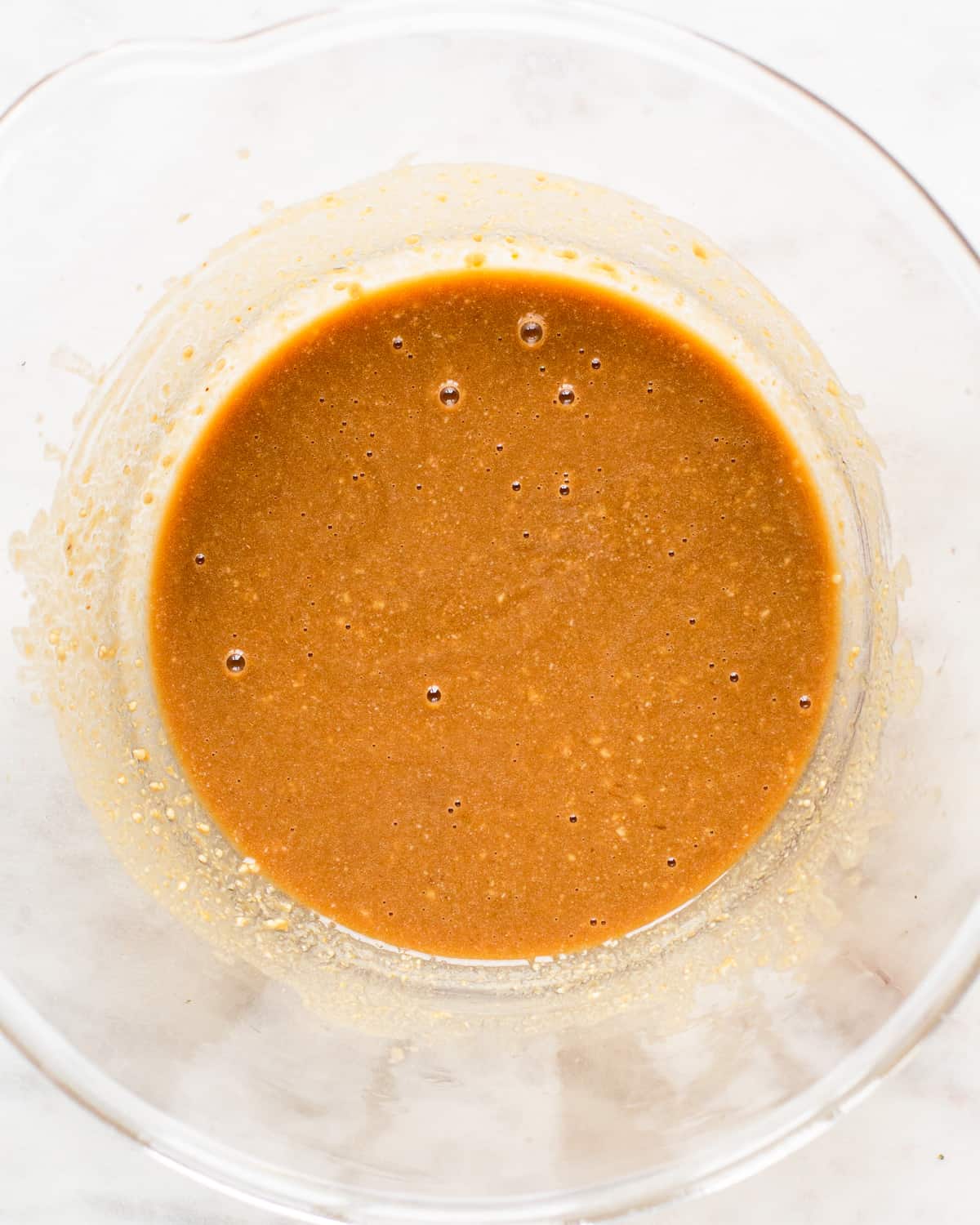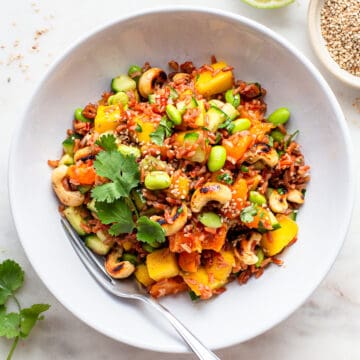Looking for a salad that you can eat all year round? This crisp and crunchy buckwheat noodle salad requires minimal preparation and comes together in less than 20 minutes. It's an ideal recipe to add to your weekly meal prep as it will stay fresh in the refrigerator for up to 4 days.

This salad recipe is packed with fresh vegetables and nutrient-rich. The edamame beans and tahini add plant-based protein to the dish, while the buckwheat noodles offer complex carbs.
Jump to:
Elo's allergy insights
Being on a gluten-free diet for over 10 years now, I know that finding new delicious vegan and gluten-free recipes, especially for light meals or simple lunches, can be quite a challenge. That's why I often draw inspiration from Asian culinary traditions, where many ingredients are naturally gluten-free, relying on staples like rice, soy, and buckwheat.
If you're not familiar with Japanese buckwheat noodles, I highly recommend giving them a try. They have a really unique taste and texture and are a true nutrition bomb. I think of them as a fun gluten-free alternative to udon noodles and a nice switch from rice noodles.
If you've never cooked buckwheat noodles before, I'm sharing all my tips and mistakes to avoid below to help you cook them perfectly the first time around.
For more easy lunches inspired by Asian cuisine, check out these simple summer rolls, nourishing nori wraps, or delicious butter lettuce wraps.
Key ingredients and substitutions

- Buckwheat noodles: Also known as soba noodles, are dark brown gluten-free noodles with a nutty, almost earthy flavor. Make sure they are made from 100% buckwheat flour if you're gluten-free, as some types of soba noodles contain wheat flour (see paragraph below). I like the ones from Clearspring or Eden Foods.
- Fresh veggies: I use a mix of carrots, red cabbage, bell peppers, and edamame beans for this salad. Almost all the colors of the rainbow.
- Tahini: It makes a great base for creamy dressings.
- Tamari: Adds some depth of flavor and a nice salty touch to the dressing. You can substitute it with coconut aminos or dark soy sauce if you're not gluten-free.
- Sesame oil: Gives the dressing a nice nutty flavor inspired by Asian cuisine.
- Fresh lime juice: Makes all the dressing flavors come together beautifully. Don't substitute it with lemon juice.
- Maple syrup: It balances the earthiness from the tahini and the acidity from the lime juice. You can replace it with brown sugar if needed.
- Toppings: sesame seeds and fresh herbs, like fresh cilantro, are my toppings of choice. You can also add sliced green onions and nori if you like.
Are soba noodles gluten-free?
There are 2 types of soba noodles, of which only 1 is gluten-free. Ju-wari soba noodles contain 80% buckwheat flour and 20% wheat flour and are not gluten-free.
Hachi-wari soba noodles, however, are made of 100% buckwheat soba flour and can safely be consumed by people with celiac disease and gluten intolerance. Those usually have a more intense nutty flavor and a firmer texture. However, they can be a little more pricey.
Elo's tips
- Swap out the tahini dressing for my creamy peanut sauce. It pairs incredibly well with this salad, too.
- Vary the vegetables and try adding thinly sliced Nappa cabbage, English cucumbers, or green beans.
- Add crispy tofu for a complete meal. Make sure to read my tofu cooking guide to obtain the crispiest tofu in a pan without using cornstarch.
How to cook soba noodles
Unlike rice noodles which a soaked in warm water, buckwheat soba noodles should be cooked in boiling water. The key is to only cook them for 4-5 minutes to prevent them from being chewy and unappetizing. Hence, why I highly recommend setting a timer.
This may be counterintuitive but you don't need to add salt to the cooking water. The noodles will be rinsed after cooking anyway and they will get seasoned by the sauce they are tossed in.
Once you add the noodles to the water, you want to make big circular motions to separate them and prevent them from sticking to each other.

Finally, you need to rinse the buckwheat noodles under cold water after cooking. This is a crucial step to stop the cooking process and keep the noodles nice and firm. It also removes excess starch that builds up during cooking and prevents the noodles from sticking to each other.
Elo's note: Buckwheat noodles create a lot of foam when cooking (due to the saponins they contain). Since the foam traps the heat, the water is likely to overflow. To prevent this from happening, make sure to stir the noodles continuously and reduce the temperature to medium-low once you add the noodles. If needed, add a cup of cold water to the pot and skim the foam.

Step-by-step instructions

STEP 1: Prep the veggies. Wash the carrots, cabbage, and bell pepper. Peel the carrots and core the yellow pepper. Cut everything into thin sticks. You can use a julienne vegetable peeler for the carrots and a mandoline for the cabbage. But you can also cut everything with a sharp knife.

STEP 2. Make the dressing. Combine the tahini with the tamari, sesame oil, lime juice, maple syrup, ground ginger, and garlic powder.

STEP 3: Cook the noodles. Boil a large pot of water (without salt) and cook the noodles according to package directions (normally for 5 minutes). Stir regularly to make sure they are not sticking to each other.

STEP 4: Rinse the noodles under cold water to stop the cooking process. It also cools down the noodles instantly which is perfect for this cold salad.

STEP 5: Toss. Add the cold buckwheat noodles with the dressing to a large bowl. Give it a good mix.
Note: if you're making this salad ahead of time, store the noodles and the dressing separately to prevent them from getting soggy.

STEP 6: Add the crunchy vegetables to the mixing bowl. Serve in your favorite noodle bowl and top with sesame seeds and fresh cilantro.
Watch how to make it
Storage tips
If you're meal-prepping portions ahead of time, store the cooked and rinsed buckwheat noodles, the dressing, and the sliced veggies in separate containers for up to 4 days in the refrigerator. You can also cook the noodles right before serving. Leftover noodles with dressing can be stored in an airtight container and should be eaten the next day.
Frequently asked questions
If your regular grocery store doesn't have them in the Asian food aisle, you will most definitely find them at Asian grocery stores near you. Many health food stores carry them, too.
Yes, 100% buckwheat soba noodles are a great source of plant-based protein and complex carbs and are very low in fat thanks to the buckwheat flour they are made of. They have a similar nutritional value to whole wheat spaghetti.
Soba noodles get chewy when they are overcooked. Make sure to only cook them for 5 minutes and rinse them under cold water right after you drain them. This stops the cooking process and keeps them al dente.

Don’t forget to join the Cooking With Elo newsletter. You’ll get gluten-free and vegan dinner ideas sent right to your inbox.
The recipe

Buckwheat Noodle Salad
Ingredients
For the salad
- 7 ounces (200 g) buckwheat soba noodles make sure they are made of 100% buckwheat flour if gluten-free
- ⅛ red cabbage
- 2 carrots
- 1 yellow bell pepper
- 1 cup (160 g) frozen shelled edamame
- 2 handfuls fresh cilantro
- 2 tablespoons sesame seeds
For the tahini dressing
- 2 tablespoons white tahini sub peanut or almond butter
- 2 tablespoons tamari sub gluten-free soy sauce
- 1 tablespoon lime juice
- 2 teaspoons toasted sesame oil
- 1 teaspoon maple syrup
- ¼ teaspoon ground ginger
- ¼ teaspoon garlic powder
Instructions
- Prep the veggies. Wash all the veggies. Peel the carrots. Thinly slice the cabbage, carrots, and bell pepper. Thaw the edamame (I use the microwave). Chop the cilantro.
- Make the dressing. Combine the tahini, tamari, sesame oil, lime juice, maple syrup, water, ground ginger, and garlic powder in a large salad bowl. Whisk until smooth.
- Cook the noodles. Bring a pot of water to a boil (no salt needed) and cook the noodles for 5 minutes. Stir regularly to prevent them from sticking and set a timer to avoid overcooking the noodles.
- Rinse the noodles under cold water. Toss them in the dressing to prevent them from sticking.
- Serve. Combine with the veggies. Serve with cilantro and sesame seeds.
Video
Notes
- You can vary the vegetables and try adding thinly sliced Nappa cabbage, English cucumbers, or green beans.
- Add crispy tofu for a complete meal. Make sure to read my tofu cooking guide to obtain the crispiest tofu in a pan without using cornstarch.
- Meal prepping tips: If you're meal prepping portions ahead of time, store the cooked and rinsed buckwheat noodles, the dressing, and the sliced veggies in separate containers for up to 4 days in the refrigerator. You can also cook the noodles right before serving.
- Leftover storage tips: Leftover noodles with dressing can be stored in an airtight container and should be eaten the next day.
- Why are my buckwheat noodles chewy? Soba noodles get chewy when they are overcooked. Make sure to only cook them for 5 minutes and to rinse them under cold water right after you drain them. This stops the cooking process and keeps them al dente.
Nutrition
Leave a star rating and review below. Thank you!
Loved it? Please rate it!
If you tried this recipe or any other recipe from the blog, make sure to let me know how you liked it by leaving a star rating and a comment below. Your feedback really matters! To never miss a recipe, follow me on Instragram, Pinterest and Facebook.






Did you like this recipe? Let me know!